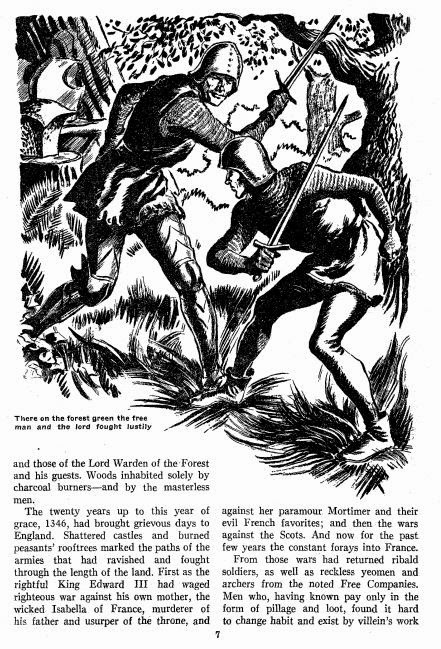 This will be brief because I didn't give myself much time to read this particular issue of the venerable pulp weekly, though all of you can catch up with the whole thing at Unz.org. Sometimes you just have other things on your mind. I did read what are probably the two main stories of the Sept. 2 issue.
This will be brief because I didn't give myself much time to read this particular issue of the venerable pulp weekly, though all of you can catch up with the whole thing at Unz.org. Sometimes you just have other things on your mind. I did read what are probably the two main stories of the Sept. 2 issue. While the cover announces a new serial, which is actually only a two-parter, the illustration gives a scene from the lead novelet, E. Hoffman Price's "Guns For Ethiopia." You'll be happy to know that despite Mussolini's invasion in 1935 there was still resistance in that country to Italian occupation. Our hero is an American gunrunner who has to negotiate with a French colonial government and Arab traders to get those guns to Ethiopia. Also at stake, to some extent, is white prestige in the entire continent. At one point, when a French governor is trying to have our hero deported, he explains some of the legal manipulation in play by stating: "It would lower white prestige, you understand, if we had you deported on the testimony of natives."

As it happens, this story set in Africa is less gruesomely racist than one might fear, no doubt because Price sympathizes with the Ethiopians as against both the Italians and the French. He makes some effort to individualize some of the hero's black crew members, who as a group are portrayed as loyal, brave and competent. Most readers should be able to enjoy this exotic adventure story with a clear conscience.

The serial is Roy S. De Horn's, "Men With No Master," announced as the first of a series starring Robin the medieval bombardier. He's a young scholar-adventurer in 14th century England who falls in with outlaws in the "New Forest" while seeking Wat the Armorer, a famed crafter of weapons. The illustrations make the Masterless Men of the forest look very much like the Merry Men of another Robin from a century or so earlier, but the story is closer to steampunk in its embrace of technology. Among the characters crossing paths in the forest is a Jewish merchant who happens to be carrying a bombard, a device that makes Robin and Wat's fascination with high-powered crossbows look obsolete. That bombard will come in handy in the next (and final) chapter, when Robin and the Masterless Men will have to save Edward the Black Prince from the sort of kidnapping by a fictional villain that seems to be the destiny of historical personages in pulp fiction. The medieval setting suggests that De Horn may have been inspired by Philip Ketchum's ongoing series about the fated axe Bretwalda, which has lingered in medieval times for several stories now. There's even a Wilton in this story, that being the name of Ketchum's dynasty of axe-wielders, though we don't know yet what weapon De Horn's character favors.

Overall, counting the stories I skipped, this looks like a good, diverse issue, including more of Luke Short's western serial Hurricane Range and the second chapter of Fred MacIsaac and C. W. Harkins's River Rogues, a presumably rollicking tale narrated in dialect about swamp boaters. Richard Sale contributes the Navy story "Mosquito" while James A Kirch gives us the baseball tale "Ghost Ball." There's more besides, but obviously I have nothing to say about the rest. Fear not, since I've already read the September 9 issue from cover to cover and will have plenty to say about that, especially considering the cover feature: the next chapter of Arthur Leo Zagat's race-war "Tomorrow" series. That's an attraction all by itself.
TO BE CONTINUED
No comments:
Post a Comment